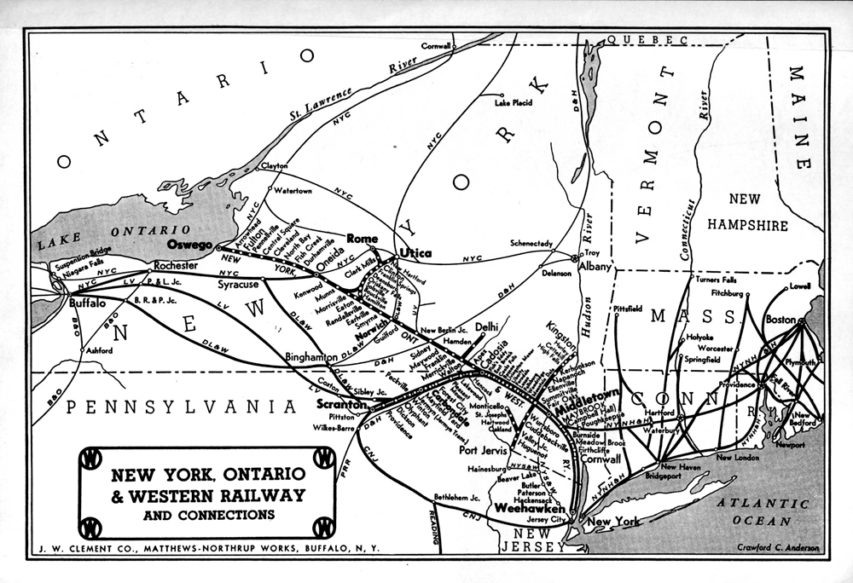 This month’s Classic Trains featured fallen flag is the New York, Ontario and Western, which ran from Oswego on the south shore of Lake Ontario down into the New York City megalopolis. Sadly, the line is best remembered as the only Class 1 US railway to be completely abandoned. John R. Taibi outlines the history of the NYO&W from formation to abandonment in 1957:
This month’s Classic Trains featured fallen flag is the New York, Ontario and Western, which ran from Oswego on the south shore of Lake Ontario down into the New York City megalopolis. Sadly, the line is best remembered as the only Class 1 US railway to be completely abandoned. John R. Taibi outlines the history of the NYO&W from formation to abandonment in 1957:

Preserved NYO&W General Electric 44-ton switcher number 104 preserved at the Southeastern Railway Museum in Duluth, GA.
Photo by Harvey Henkelmann via Wikimedia Commons.
The New York, Ontario & Western Railway struggled to find its place among the many transportation systems serving New York City, but in the end it was able only to secure a place in history as the first Class I railroad to be abandoned in entirety. Despite this unenviable status, “the O&W,” as it was known, did endear itself to the communities along its line. After all, it was the carrier that had brought boxcars full of prosperity to every community along the line during its 76-year life.
Begun on January 21, 1880, the O&W set a goal of improving the Oswego–New York corridor, as well as the branches to New Berlin, Delhi, and Ellenville, N.Y., it had inherited from the New York & Oswego Midland. The O&W developed a new entrance to Gotham from Middletown, N.Y., that ran to Cornwall on the Hudson River, thence to Weehawken, N.J., by rights on the New York, West Shore & Buffalo Railway (later New York Central).
[…]
As it improved its physical characteristics, the O&W also acquired modern motive power to haul its numerous coal, milk, passenger, and general freight trains. Where previously Camelback 4-4-0s, 2-6-0s, and 2-8-0s were as common as the road’s wooden coaches and country depots, a corps of end-cab locomotives helped usher in the new era. E-class Ten-Wheelers (1911), W-class Consolidations (1910-11), X-class 2-10-2 “Bull Mooses” (1915), and Y-class Mountains (1922 and ’29) provided the power for passenger trains to the Catskills, milk trains to Gotham, and coal trains to Oswego, Cornwall, and Weehawken. Still, many Camelbacks worked into the mid-1940s.
This familiar, widely circulated O&W map was created by cartographer Crawford C. Anderson.
Classic Trains.[…]
Dieselization was hoped to be a savior, and under [O&W bankruptcy trustee, Frederick E.] Lyford’s direction a handful of GE 44-ton switchers arrived in 1941. Nine two-unit EMD FTs came in 1945 and were put into fast merchandise service between Scranton and Maybrook, and Scranton and Norwich. Lyford’s successors in 1948 acquired additional F3 and NW2 diesels, enough to banish steam locomotives from service by that summer.
By that time, though, O&W’s accumulated losses amounted to $38 million. It was beyond the ability of trustees, the reorganization court, and diesel locomotives to extricate the carrier from financial ruin. Nevertheless, passenger trains from Weehawken to Walton (then only to Roscoe) kept running until mail contracts gave out in 1950; the service was suspended in September 1953. Although milk and coal trains were a memory, gray-yellow-and-orange diesel locomotives soldiered on, leading a dwindling number of ever-shorter freight trains.
By the mid-1950s, the reorganization court — which had been searching for a buyer for the road now truly earning another of its nicknames, the “Old & Weary” — was advocating total abandonment. Additionally, the U.S. government was suing for taxes and retirement payments that were in arrears, and New York state began planning on how best to use the O&W right of way for highway improvements.




